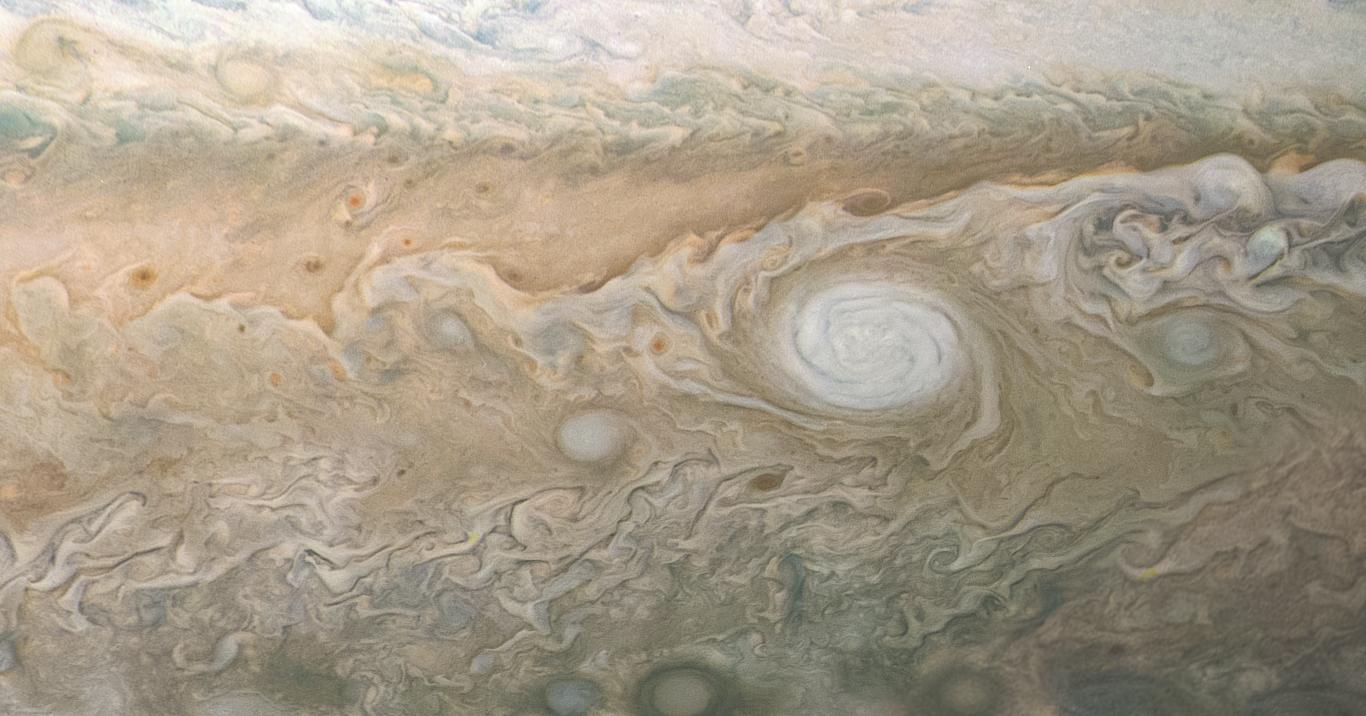
|
Jovian White Oval
- Click the image above for a larger view
- Full-Res JPEG (1366 x 716) (130.5 kB)
- Full-Res TIFF (1366 x 716) (2.9 MB)
Caption:
A swirling, oval white cloud in Jupiter's South South Temperate Belt is captured in this image from NASA's Juno spacecraft. Known as White Oval A5, the feature is an anticyclonic storm. An anticyclone is a weather phenomenon where winds around the storm flow in the direction opposite to those of the flow around a region of low pressure.
Juno took the two images used to produce this color-enhanced view on Sept. 6, 2018, at 6:45 p.m. PDT (9:45 p.m. EDT) and 6:58 p.m. PDT (9:58 p.m. EDT) as the Juno spacecraft performed its 15th close flyby of Jupiter. At the time the images were taken, the spacecraft was about 25,000 miles (40,500 kilometers) to 39,000 miles (63,000 kilometers) from Jupiter's cloud tops, above a southern latitude spanning from about 54 to 66 degrees.
Citizen scientist Kevin M. Gill created this image using data from the spacecraft's JunoCam imager.
Background Info:
JunoCam's raw images are available at www.missionjuno.swri.edu/junocam for the public to peruse and process into image products.
More information about Juno is online at http://www.nasa.gov/juno and http://missionjuno.swri.edu .
NASA's Jet Propulsion Laboratory manages the Juno mission for the principal investigator, Scott Bolton, of Southwest Research Institute in San Antonio. Juno is part of NASA's New Frontiers Program, which is managed at NASA's Marshall Space Flight Center in Huntsville, Alabama, for NASA's Science Mission Directorate. Lockheed Martin Space Systems, Denver, built the spacecraft. Caltech in Pasadena, California, manages JPL for NASA.
Cataloging Keywords:
| Name | Value | Additional Values |
|---|---|---|
| Target | Jupiter | |
| System | Jupiter | |
| Target Type | Planet | |
| Mission | Juno | |
| Instrument Host | Juno | |
| Host Type | Orbiter | |
| Instrument | JunoCam | |
| Detector | ||
| Extra Keywords | Atmosphere, Color, Storm, Visual | |
| Acquisition Date | ||
| Release Date | 2018-10-25 | |
| Date in Caption | ||
| Image Credit | Enhanced image by Kevin M. Gill (CC-BY) based on images provided courtesy of NASA/JPL-Caltech/SwRI/MSSS. Media Usage Guidelines | |
| Source | photojournal.jpl.nasa.gov/catalog/PIA22691 | |
| Identifier | PIA22691 | |
